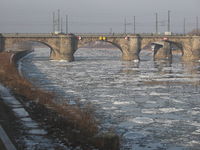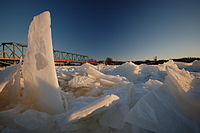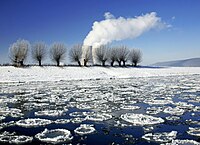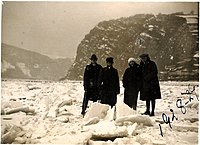Ice drift


When floating ice drifting ( "go") is of ice on flowing waters ( rivers , Wadden Sea ), respectively. This phenomenon occurs in two periods. On the one hand, there is ice drift when ice floes form on the rivers in winter . On the other hand, ice drift is known in connection with snowmelt . The ice drift is particularly dangerous when a thick sheet of ice has formed on a river in a severe winter and this breaks up due to rapidly rising temperatures in combination with rain and thus drifting ice blocks weighing several tons on the river. These can damage buildings (such as the Cellitinnenkloster Dreifaltigkeit in Cologne in 1784 ) or destroy them (such as the Heidelberg Old Bridge in the same year). Bridge piers can be equipped with " icebreakers " to protect against ice drift .
In addition, chunks of ice can become wedged on narrow stretches of river or bridge piers and thus dammed the river. In order to avoid major damage, such ice jams have already been bombed in Russia, for example.
Ice drifts are rare in Germany. This is mainly due to the fact that the winter months are repeatedly interrupted by warm periods. Another reason is the discharge of warm wastewater from industry and private households. This wastewater has ensured that the Rhine has not frozen over since the winter of 1963 (for more information, see Rhine # ice formation ). In Germany, the Oder has the most regular ice drift. It is Germany's easternmost river (see continental climate ).
One of the most serious weather events of the last decades were three cold waves with lots of snow and ice drift in numerous ports and rivers, which hit northern Germany and northern parts of the GDR in the winter of 1978/79 .
Ice drift on the Elbe in Dresden on January 29, 2006
Ice drift on the Weser , in the background flags of condensed steam from the Grohnde nuclear power plant
See also
- Ice reservoir
- Ice rush
- Cold spell
- List of weather events in Europe (sorted by "event")




